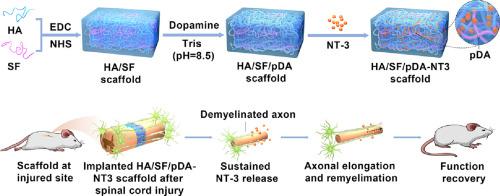Acta Biomaterialia ( IF 9.4 ) Pub Date : 2023-05-29 , DOI: 10.1016/j.actbio.2023.05.044 Qi Sha 1 , Yankai Wang 2 , Zhi Zhu 1 , Hu Wang 1 , Hua Qiu 2 , Weirui Niu 2 , Xiangyang Li 2 , Jun Qian 1

|
Bio-factor stimulation is essential for axonal regeneration in the central nervous system. Thus, persistent and efficient factor delivery in the local microenvironment is an ideal strategy for spinal cord injury repair. We developed a biomimetic hydrogel scaffold to load biofactors in situ and release them in a controlled way as a promising therapeutic modality. Hyaluronic acid and silk fibroin were cross-linked as the basement of the scaffolds, and poly-dopamine coating was used to further increase the loading of factors and endow the hydrogel scaffolds with ideal physical and chemical properties and proper biocompatibility. Notably, neurotrophin-3 release from the hydrogel scaffolds was prolonged to 28 days. A spinal cord injury model was constructed for hydrogel scaffold transplantation. After eight weeks, significant NF200-positive nerve fibers were observed extending across the glial scar to the center of the injured area. Due to the release of neurotrophin-3, spinal cord regeneration was enhanced, and the cavity area of the injury graft site and inflammation associated with CD68 positive cells were reduced, which led to a significant improvement in hind limb motor function. The results show that the hyaluronic acid/silk fibroin/poly-dopamine-coated biomimetic hydrogel scaffold achieved locally slow release of neurotrophin-3, thus facilitating the regeneration of injured spinal cord.
Statement of significance
Hydrogels have received great attention in spinal cord regeneration. Current research has focused on more efficient and controlled release of bio-factors. Here, we adopted a mussel-inspired strategy to functionalize the hyaluronic acid/silk fibroin hydrogel scaffold to increase the load of neurotrophin-3 and extend the release time. The hydrogel scaffolds have ideal physiochemical properties, proper release rate, and biocompatibility. Owing to the continuous neurotrophin-3 release from implanted scaffolds, cavity formation is reduced, inflammation alleviated, and spinal cord regeneration enhanced, indicating great potential for bio-factor delivery in soft tissue regeneration applications.
中文翻译:

一种掺有神经营养素 3 的透明质酸/丝素蛋白/聚多巴胺涂层仿生水凝胶支架,用于脊髓损伤修复
生物因子刺激对于中枢神经系统的轴突再生至关重要。因此,局部微环境中持续有效的因子递送是脊髓损伤修复的理想策略。我们开发了一种仿生水凝胶支架,可以在原位加载生物因子并以受控方式释放它们,作为一种有前途的治疗方式。以透明质酸和丝素蛋白交联作为支架的基底,并采用聚多巴胺涂层进一步增加因子负载,赋予水凝胶支架理想的理化性能和适当的生物相容性。值得注意的是,神经营养素 3 从水凝胶支架的释放时间延长至 28 天。构建用于水凝胶支架移植的脊髓损伤模型。八周后,观察到明显的 NF200 阳性神经纤维穿过神经胶质疤痕延伸到受伤区域的中心。由于神经营养蛋白-3的释放,脊髓再生增强,损伤移植部位的空洞面积和与CD68阳性细胞相关的炎症减少,从而导致后肢运动功能显着改善。结果表明,透明质酸/丝素蛋白/聚多巴胺涂覆的仿生水凝胶支架实现了神经营养蛋白-3的局部缓慢释放,从而促进受损脊髓的再生。
重要性声明
水凝胶在脊髓再生方面受到了极大的关注。目前的研究重点是更有效和受控地释放生物因子。在这里,我们采用了受贻贝启发的策略来功能化透明质酸/丝素蛋白水凝胶支架,以增加神经营养蛋白-3的负载并延长释放时间。水凝胶支架具有理想的理化性质、适当的释放速率和生物相容性。由于植入支架持续释放神经营养蛋白-3,空腔形成减少,炎症减轻,脊髓再生增强,表明生物因子递送在软组织再生应用中具有巨大潜力。


















































 京公网安备 11010802027423号
京公网安备 11010802027423号